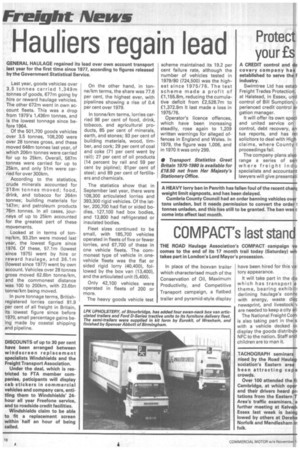Hauliers regain lead
Page 8

If you've noticed an error in this article please click here to report it so we can fix it.
GENERAL HAULAGE regained its lead over own account transport last year for the first time since 1977, according to figures released by the Government Statistical Service.
Last year, goods vehicles over 3.5 tonnes carried 1,349m tonnes of goods, 677m going by hire or reward haulage vehicles. The other 672m went in own account fleets. This was a drop from 1979`s 1,436m tonnes, and is the lowest tonnage since before 1964.
Of the 501,700 goods vehicles over 3.5 tonnes, 108,200 were over 28 tonnes gross, and these moved 648m tonnes last year, of which 206m tonnes were carried for up to 25km. Overall, 587m tonnes were carried for up to 25km, and only 51m were carried for over 300km.
According to the statistics, crude minerals accounted for 318m tonnes moved; food, drink, and tobacco for 264m tonnes; building materials for 147m; and petroleum products 76m tonnes. In all cases, journeys of up to 25km accounted for the greatest part of these movements.
Looked at in terms of tonne/km, 93.2bn were moved last year, the lowest figure since 1976. Of these, 57.1m (lowest since 1975) went by hire or reward haulage, and 36.1 m (lowest since 1977) went by own account. Vehicles over 28 tonnes gross moved 62.8bn tonne/km, and the commonest distance was 100 to 200km, with 23.6bn tonne/km being moved.
In pure tonnage terms, Britishregistered lorries carried 81.9 per cent of all freight in Britain, its lowest figure since before 1970, small percentage gains being made by coastal shipping and pipeline. On the other hand, in tonne/km terms, the share was 77.6 per cent, the highest ever, with pipelines showing a rise of 0.4 per cent over 1979.
In tonne/km terms, lorries carried 98 per cent of food, drink, tobacco, and agricultural products, 85 per cent of minerals, earth, and stones; 93 per cent of building materials, wood, timber, and cork; 29 per cent of coal and coke (71 per cent went by rail); 27 per cent of oil products (14 percent by rail and 59 per cent by pipline); 81per cent of steel; and 89 per cent of fertilisers and chemicals.
The statistics show that in September last year, there were 108,300 articulated lorries and 393,300 rigid vehicles. Of the latter, 200,700 had flat or sided bodies, •127,100 had box bodies, and 13,800 had refrigerated or insulated bodies.
Fleet sizes continued to be small, with 185,700 vehicles operated in fleets of five or fewer lorries, and 67,700 of these in one vehicle fleets. The commonest type of vehicle in onevehicle fleets was the flat or sided rigid lorry (40,400), followed by the box van (13,400), and the articulated unit (5,400).
Only 42,100 vehicles were operated in fleets of 200 or more.
The heavy goods vehicle test scheme maintained its 19.2 per cent failure rate, although the number of vehicles tested in 1979/80 (724,500) was the highest since 1975/76. The test scheme made a profit of £1,155.8m, reducing the cumulative deficit from £2,528,7m to £1,372.9m It last made a loss in 1975/76.
Operator's licence offences, which have been increasing steadily, rose again to 1,209 written warnings for alleged offences in England and Wales. In 1979, the figure was 1,006, and in 1970 it was only 299.
• Transport Statistics Great Britain 1970-1980 is available for £18.50 net from Her Majesty's Stationery Office.






















































































